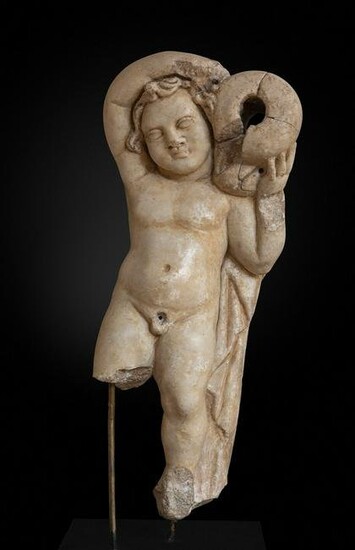Fountain with putti or erote. Roman Empire, 2nd century
Fountain with putti or erote. Roman Empire, 2nd century AD.
In marble.
Dimensions: 70 x 30 x 20 cm. figure; 15,5 x 30 x 30 x 30 cm. (base).
Sculpture of a child holding an amphora or jar on his left shoulder. The hollowness of the jug indicates that it was a fountain, probably designed to decorate a domus or villa, i.e. a domestic space. Sculptures of this type of infants, Erotes or amorcillos in various poses were very common in the gardens and peristyles of Roman villae. In these family gardens, statues of a Bacchic style, due to their relationship with nature, helped to create an atmosphere in which to enjoy a bucolic setting. The erote in question bends his torso slightly to carry the vessel, which lends a naturalness to the posture. The kinky hair frames soft features with almond-shaped eyes and full lips. The child wears a cloak intended not so much to cover his nakedness as to cushion the weight of the jar. It falls to the ground in soft folds. The sculptural reference has its origins in Hellenistic representations, based on models that inspired Roman statuary from the High-Imperial period. In the phidiac reliefs of the Parthenon, in the context of the Panathenaic festivals, young women in procession, the hydrophorae, go to offer water to the divinity, carrying an amphora on their left shoulder. However, it was not until later that this theme became more popular and its use became widespread as a fountain decoration. Its origin with this value can be traced back to Hellenism, when an artistic movement known as "Hellenistic Rococo" was generated, characterised by the use of sculptures with an eminently decorative character, among which the representation of children, erotes or putti proliferated. These subjects would later develop considerably in the Roman period and would play an important ornamental role in certain spaces, especially in private areas, in those areas of the domus dedicated to the enjoyment of leisure.
Estimate
Time, Location
Auction House
Fountain with putti or erote. Roman Empire, 2nd century AD.
In marble.
Dimensions: 70 x 30 x 20 cm. figure; 15,5 x 30 x 30 x 30 cm. (base).
Sculpture of a child holding an amphora or jar on his left shoulder. The hollowness of the jug indicates that it was a fountain, probably designed to decorate a domus or villa, i.e. a domestic space. Sculptures of this type of infants, Erotes or amorcillos in various poses were very common in the gardens and peristyles of Roman villae. In these family gardens, statues of a Bacchic style, due to their relationship with nature, helped to create an atmosphere in which to enjoy a bucolic setting. The erote in question bends his torso slightly to carry the vessel, which lends a naturalness to the posture. The kinky hair frames soft features with almond-shaped eyes and full lips. The child wears a cloak intended not so much to cover his nakedness as to cushion the weight of the jar. It falls to the ground in soft folds. The sculptural reference has its origins in Hellenistic representations, based on models that inspired Roman statuary from the High-Imperial period. In the phidiac reliefs of the Parthenon, in the context of the Panathenaic festivals, young women in procession, the hydrophorae, go to offer water to the divinity, carrying an amphora on their left shoulder. However, it was not until later that this theme became more popular and its use became widespread as a fountain decoration. Its origin with this value can be traced back to Hellenism, when an artistic movement known as "Hellenistic Rococo" was generated, characterised by the use of sculptures with an eminently decorative character, among which the representation of children, erotes or putti proliferated. These subjects would later develop considerably in the Roman period and would play an important ornamental role in certain spaces, especially in private areas, in those areas of the domus dedicated to the enjoyment of leisure.



